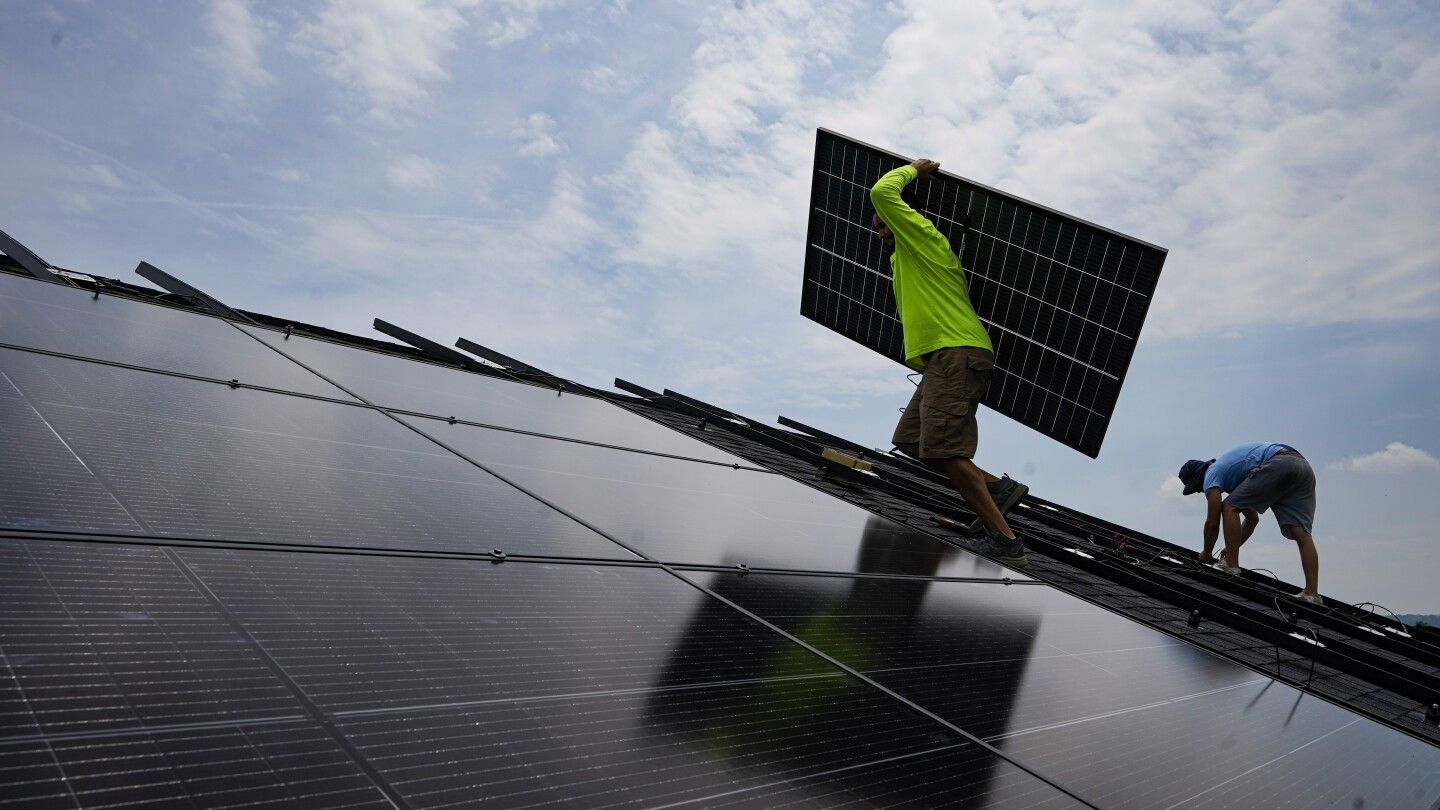One year old, US climate law is already turbocharging clean energy technology
FRANKFORT, Ky. (AP) — On a recent day under the July sun, three men heaved solar panels onto the roof of a roomy, two-story house near the banks of the Kentucky River, a few miles upstream from the state capitol where lawmakers have promoted coal for more than a century.
The U.S. climate law that passed one year ago offers a 30% discount off this installation via a tax credit, and that’s helping push clean energy even into places where coal still provides cheap electricity. For Heather Baggett’s family in Frankfort, it was a good deal.
“For us, it’s not politically motivated,” said Baggett. “It really came down to financially, it made sense.”
On August 16, after the hottest June ever recorded and a scorching July, America’s long-sought response to climate change, the Inflation Reduction Act, turns one year old. In less than a year it has prompted investment in a massive buildout of battery and EV manufacturing across the states. Nearly 80 major clean energy manufacturing facilities have been announced, an investment equal to the previous seven years combined, according to the American Clean Power Association.
“It seems like every week there’s a new factory facility somewhere” being announced, said Jesse Jenkins, a professor at Princeton and leader of the REPEAT Project which has been deeply involved in analysis of the law.
“We’ve been talking about bringing manufacturing jobs back to America for my entire life. We’re finally doing it, right? That’s pretty exciting,” he said.
Nicholas Hartnett, owner of Pure Power Solar, lifts a solar panel to the roof of a home in Frankfort, Ky., Monday, July 17, 2023. (AP Photo/Michael Conroy)
Brian Hoeppner, left, and Even Berrios, install a solar panel on the roof of a home in Frankfort, Ky., Monday, July 17, 2023. (AP Photo/Michael Conroy) Nicholas Hartnett, owner of Pure Power Solar, secures solar panel on the roof of a home in Frankfort, Ky., Monday, July 17, 2023. (AP Photo/Michael Conroy)
Brian Hoeppner, left, and Nicholas Hartnett, owner of Pure Power Solar, install a solar panel on the roof of a home in Frankfort, Ky., Monday, July 17, 2023. (AP Photo/Michael Conroy)
The IRA is America’s most significant response to climate change, after decades of lobbying by oil, gas and coal interests stalled action, while carbon emissions climbed, creating a hotter, more dangerous world. It is designed to spur clean energy buildout on a scale that will bend the arc of U.S. greenhouse gas emissions. It also aims to build domestic supply chains to reverse China’s and other nations’ early domination of this vital sector.
One target of the law is cleaner transportation, the largest source of climate pollution for the U.S. Siemens, one of the biggest tech companies in the world, produces charging stations for EVs. Executives say this alignment of U.S. policy on climate is driving higher demand for batteries.
“When the federal government makes an investment, we get to the tipping point faster,” said Barbara Humpton, CEO of Siemens USA, adding that the company has invested $260 million in battery or battery storage projects in recent years.
The law also encourages more of the type of batteries that feed electricity to the grid when the wind is slack, or at night when the sun isn’t hitting solar panels. It could put the storage business on the same upward trajectory that solar blazed a decade ago, said Michael McGowan, head of North American infrastructure private markets for Mercer Alternatives, a consulting firm.
FILE - An electric vehicle is plugged into a charger in Los Angeles, Aug. 25, 2022. (AP Photo/Jae C. Hong, File)
Wind turbines work at sunset on a wind farm near Del Rio, Texas, Feb. 15, 2023. (AP Photo/Eric Gay)
Derrick Flakoll, North America policy associate at Bloomberg NEF, pointed out that sales at the largest manufacturer of solar panels in the U.S., First Solar, skyrocketed after the law passed, creating a big backlog of orders.
“This is years and years of manufacturing capacity that is already booked out because people are bullish about the U.S.-produced solar market,” he said.
The IRA is also helping technologies that are expensive, but promising for near-term decarbonization.
Jason Mortimer is senior vice president of global sales at EH2, which makes large, low-cost electrolyzers — machines that split hydrogen from water. Hydrogen as clean energy is still in its infancy. “The IRA accelerates the implementation of hydrogen at scale by about four to five years,” making the U.S. competitive with Europe, he said.
But these changes, significant as they are, may just be the beginning, experts say.
“I think we’re about to see a quite a flood of investment in wind and solar-related manufacturing in the U.S.,” Jenkins said, adding that 2026 to 2028 is when the country will see the law’s full impact.
Other countries, some of them ahead of the U.S. in addressing climate change, have enacted their own further efforts to speed the changeover to clean energy. Canada has announced a matching policy and Europe has its own measures to attract manufacturing, similar to the IRA.
“European and Japanese automakers are trying to think about how to change supply chains in order to try and compete,” said Neil Mehrotra, assistant vice president and policy advisor at the Federal Reserve Bank of Minneapolis and contributor to a report about the U.S. law published by the Brookings Institution.
The Congressional Budget Office initially estimated the IRA’s tax credits would cost about $270 billion over a decade, but Brookings says businesses might take advantage of the credits far more aggressively and the federal government could pay out three or four times more.
Brian Hoeppner, right, and Even Berrios, install a solar panel on the roof of a home in Frankfort, Ky., Monday, July 17, 2023. (AP Photo/Michael Conroy)
The law is supposed to reduce the emissions of the U.S. — the country most responsible for greenhouse gases historically — by as much as 41% by 2030, according to a new analysis by Princeton researchers. That’s not enough to hit U.S. goals, but is a significant improvement.
But those crucial greenhouse gas cuts are partially at risk if the U.S. electric grid cannot grow enough to connect new wind and solar farms and handle new demands, like mass vehicle charging.
Despite the new investment in red states, not everyone likes it. Republicans recently proposed repealing major elements of the law. And Frankfort resident Jessie Decker, whose neighbor has solar panels, said he wouldn’t consider them, and doesn’t think the federal government should be “wasting money” on dubious climate programs.
Nor does the law mean climate-warming oil and gas are going away.
“Frankly, we are going to be using fossil fuels for many decades to come,” said Fred Eames, a regulatory attorney with the law firm Hunton Andrews Kurth.
Up on Baggett’s roof, Nicholas Hartnett, owner of Pure Power Solar, is pleased that business is up and homeowners are opening up to solar once they see how they can financially benefit.
“You have the environmental side, which handles the left, and then you have the option to use your own tax money that the government would have otherwise taken, which gets the right checked off,” he said.
___
The Associated Press receives support from the Walton Family Foundation for coverage of water and environmental policy. The AP is solely responsible for all content. For all of AP’s environmental coverage, visit https://apnews.com/hub/climate-and-environment
Source: The Associated Press


